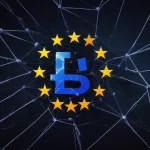A7A5 Ruble Stablecoin Moves $9.3B on Grinex: Sanctions Evasion or Innovation?

Ruble-Backed A7A5 Stablecoin Hits $9.3B on Grinex: Sanctions Evasion or Crypto Innovation?
A Russian ruble-pegged stablecoin, A7A5, has processed a jaw-dropping $9.3 billion in transactions on Grinex, a cryptocurrency exchange widely seen as the successor to the sanctioned platform Garantex. With deep ties to sanctioned entities and serious doubts about its organic adoption, this development raises critical questions about the role of crypto in bypassing international restrictions.
- Massive Transactions: A7A5 moved $9.3 billion on Grinex, with activity heavily concentrated in just 124 wallets.
- Sanctioned Ties: Backed by reserves at the sanctioned Promsvyazbank and linked to controversial figure Ilan Shor, A7A5 sparks concern.
- Adoption Doubts: Blockchain analytics suggest internal fund shifts rather than genuine user engagement.
A7A5’s Staggering $9.3 Billion Volume on Grinex
Let’s get straight to the point: $9.3 billion in transactions for a ruble-backed cryptocurrency is no trivial matter, especially when it’s happening on Grinex, a platform emerging from the shadow of Garantex, a Russian exchange hit hard by U.S. Treasury sanctions for facilitating illicit finance. Before its shutdown in March 2024, Garantex processed over $60 billion in transactions, much of it linked to ransomware payments, money laundering, and other criminal enterprises. When the hammer dropped, Tether froze $27 million in USDT tied to Garantex, a move that disrupted the crypto underworld. Now, Grinex steps into the spotlight, and while it denies any direct connection to its predecessor, claiming to serve only users with a “transparent history,” the evidence suggests otherwise. Blockchain analytics and investigative reports point to a seamless migration of liquidity and user balances from Garantex to Grinex, hinting at a deliberate strategy to keep the funds flowing, as detailed in this analysis of Grinex as Garantex’s likely rebrand.
“Garantex users with outstanding balances at the time it was shut down could have these balances credited to new accounts set up on Grinex.” – Tom Robinson, co-founder of Elliptic
For those just dipping their toes into crypto, a stablecoin like A7A5 is a digital asset designed to hold a steady value by being pegged to a traditional currency, here the Russian ruble. Think of it as a digital dollar bill in a crypto wallet, meant to stay stable while coins like Bitcoin ride a rollercoaster of price swings. A7A5 claims a 1:1 backing with ruble reserves, meaning for every token issued, there’s supposedly a ruble held in reserve to back it. But here’s where the plot thickens: those reserves are reportedly parked at Promsvyazbank, a Moscow-based institution under Western sanctions for its role in financing Russia’s military-industrial complex amid the Ukraine conflict. If that doesn’t raise an eyebrow, I don’t know what will. For more background on stablecoins, check this comprehensive overview of stablecoin mechanics.
Ties to Sanctioned Entities and Murky Connections
Promsvyazbank isn’t just any bank; it’s a key player in Russia’s military financing, targeted by sanctions from the U.S. and EU for directly supporting defense contracts and state-backed initiatives. Its involvement with A7A5 suggests a potential channel for moving funds outside the traditional banking system, a tactic often used to dodge international restrictions. But the red flags don’t stop there. A7A5 has also been linked to Ilan Shor, a sanctioned Moldovan businessman convicted of fraud in a $1 billion banking scandal in Moldova. Despite A7A5’s claim that it cut ties with Shor’s earlier A7 project in May 2025, Shor was spotted promoting the stablecoin at the St. Petersburg International Economic Forum in June 2025. That’s not exactly the clean break they promised, is it? Investigative reports, including this detailed look at Ilan Shor’s ties to A7A5, even point to shared digital infrastructure between A7A5 and domains tied to Shor’s political activities in Moldova, including alleged election interference.
“Russian business figures and government officials have been talking for a while about how they might use cryptocurrency to evade sanctions in a large-scale way, particularly by creating their own stablecoin.” – Elise Thomas, CIR
CIR frames A7A5 as part of a hybrid fiat-crypto system designed for large-scale money transfers in and out of Russia, a workaround increasingly floated by Russian elites to sidestep sanctions. Add to this the fact that A7A5 was launched in Kyrgyzstan, a Central Asian nation with relatively lax regulations, and you’ve got a classic setup. Smaller jurisdictions like Kyrgyzstan often attract crypto projects looking to avoid the stricter oversight of places like the U.S. or EU. A7A5 claims compliance with local laws and audits by a Kyrgyz firm, but let’s be real—Kyrgyzstan seems to be the new Wild West for crypto outfits dodging the sheriff of international law. For further insights into these massive transactions, see this report on A7A5’s $9.3B movement on Grinex.
Doubts on Organic Adoption: A Shell Game?
Now, let’s crunch some numbers and pour a bucket of cold water on the hype. A7A5 sports a market cap of $151 million with 12 million tokens in circulation, listed solely on Uniswap, a decentralized exchange. On-chain data from Etherscan and Tronscan shows about 24,000 holders, which might sound promising at first. But dig deeper, and the picture gets murky. Of that $9.3 billion in transaction volume on Grinex, a staggering $4.6 billion came from just eight wallets. Expand to 124 wallets, and you’ve covered nearly all the activity. Blockchain analytics firm Elliptic notes that these transfers follow “rigid fixed patterns,” often happening during Moscow office hours—like clockwork, almost as if automated or orchestrated by insiders rather than driven by random user trades. So, is A7A5 a bustling marketplace or just a few players passing billions around in a high-stakes hot potato game? We’re leaning toward the latter, as supported by this Elliptic analysis of A7A5’s $9.3 billion transactions.
Elliptic’s analysis suggests these movements resemble internal banking processes, not consumer usage or even typical money laundering patterns. This casts serious doubt on A7A5’s claim of meeting a demand for non-USD stablecoins. Sure, the ruble’s volatility could theoretically open up carry trade opportunities—borrowing in a low-interest currency to invest in a higher-interest one for profit—but when the optics are this bad, tied to a sanctioned bank and a platform like Grinex, it’s hard to take such justifications at face value.
A7A5 and the Broader Stablecoin Market
Could A7A5, despite its baggage, signal a trend? As sanctions tighten around nations like Russia, state-backed or fiat-pegged stablecoins might become a go-to tool for navigating financial isolation. Imagine other countries following suit, launching their own stablecoins to bypass USD dominance or Western banking systems. On one hand, this could diversify the stablecoin market, challenging the reign of USDT or USDC and aligning with the decentralization ethos we champion. On the other hand, it risks turning blockchain into a playground for state actors and sanctioned entities, undermining the very freedom and privacy Bitcoin stands for. As Bitcoin maximalists, we see BTC as the ultimate disruptor, but we can’t ignore how altcoins and stablecoins fill niches—however shady—that Bitcoin itself doesn’t touch. The sheer scale of A7A5’s activity is under heavy scrutiny, as noted in this report on ruble-backed stablecoin transaction volumes.
Even if A7A5 is filling a genuine need for ruble-based transactions in a sanctions-hit economy, the data screams skepticism. The concentration of activity, the rigid patterns, the geopolitical ties—it all points to something more orchestrated than organic. This could be a test case for how crypto evolves under regulatory pressure, but it’s not the kind of acceleration we’re rooting for. We want effective accelerationism, sure, but not at the cost of credibility or ethics.
Global Crackdowns: Crypto’s Double-Edged Sword
While the A7A5 saga unfolds, law enforcement worldwide is tightening the screws on crypto’s darker corners, highlighting the tightrope blockchain walks between freedom and crime. Europol recently dismantled Archetyp Market, a major dark web marketplace, in a coordinated raid across six countries. In the U.S., authorities seized crypto linked to BidenCash, a platform peddling stolen credit card data, while taking down 145 associated domains. Separately, the Department of Justice confiscated over $24 million in cryptocurrency from a Russian national tied to the Qakbot malware operation. These actions, while unrelated to A7A5, underscore a critical point: every story like Grinex or A7A5 chips away at the reputation of legitimate projects. Bitcoin and genuine blockchain innovations suffer guilt by association when bad actors exploit the tech we hold dear, a concern echoed in discussions around A7A5 transactions and sanctions evasion.
This broader crackdown also begs the question of better Know Your Customer (KYC) and Anti-Money Laundering (AML) practices in crypto. While we’re all for privacy and decentralization, the reality is that stories like this fuel regulatory overreach. If crypto is to thrive, it needs to weed out the grifters without sacrificing its core principles—a tall order, but a necessary one. The connection between Grinex and Garantex only amplifies these concerns, as explored in this report on Grinex’s ties to the sanctioned platform.
Key Takeaways and Questions on A7A5, Grinex, and Crypto’s Future
- What does A7A5’s $9.3 billion volume on Grinex mean for the crypto space?
It highlights a massive flow of funds through a ruble-pegged cryptocurrency on a platform tied to a sanctioned exchange, raising alarms about potential sanctions evasion and illicit activity. - Why are experts questioning A7A5’s adoption claims?
With transactions concentrated in just 124 wallets and following predictable patterns during Moscow office hours, the activity looks more like internal fund shifts than decentralized user engagement. - How does Grinex relate to the sanctioned Garantex, and why is this significant?
Grinex is seen as Garantex’s successor, likely inheriting its users and liquidity, which matters because it suggests ongoing efforts to bypass international sanctions via crypto platforms. - What’s problematic about A7A5’s links to Promsvyazbank and Ilan Shor?
Connections to a sanctioned bank and a convicted fraudster undermine A7A5’s legitimacy, hinting at its possible use in questionable financial or political schemes. - How do global law enforcement actions tie into this narrative?
Takedowns of dark web markets and malware operations, though unrelated to A7A5, reflect a wider regulatory push against crypto misuse, contrasting with blockchain’s potential for legitimate disruption. - Could A7A5 impact the future of stablecoins or Bitcoin’s dominance?
It might inspire other nations to launch fiat-backed stablecoins as sanctions workarounds, diversifying the market but risking crypto’s credibility—something Bitcoin and decentralization advocates must grapple with.
We’re rooting for Bitcoin and blockchain to redefine finance on terms of freedom, privacy, and disruption of bloated systems. But let’s not kid ourselves—stories like A7A5 and Grinex are a gut check. If crypto is going to be the future of money, it can’t double as a backdoor for sanctioned entities or political hustlers. This ruble-backed stablecoin might be carving out a niche, but the red flags are flying high. We’re not here to peddle hype or sugarcoat reality; we’re here to lay out the messy truth. Blockchain’s promise is immense, but only if we keep the grifters at bay. A7A5 might just be a test case—let’s not fail it by turning a blind eye.



